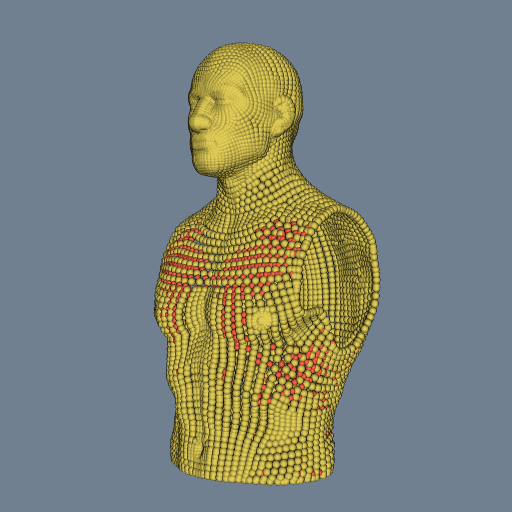DensifyPoints
Repository source: DensifyPoints
Description¶
In this example, the original points are yellow and the added points are red.
The image was produced using src/Testing/Data/Torso.vtp.
Other languages
See (PythonicAPI)
Question
If you have a question about this example, please use the VTK Discourse Forum
Code¶
DensifyPoints.cxx
#include <vtkCamera.h>
#include <vtkDensifyPointCloudFilter.h>
#include <vtkGlyph3DMapper.h>
#include <vtkMinimalStandardRandomSequence.h>
#include <vtkNamedColors.h>
#include <vtkNew.h>
#include <vtkPointSource.h>
#include <vtkProperty.h>
#include <vtkRenderWindow.h>
#include <vtkRenderWindowInteractor.h>
#include <vtkRenderer.h>
#include <vtkSmartPointer.h>
#include <vtkSphereSource.h>
#include <vtksys/SystemTools.hxx>
#include <vtkBYUReader.h>
#include <vtkOBJReader.h>
#include <vtkPLYReader.h>
#include <vtkPolyDataReader.h>
#include <vtkSTLReader.h>
#include <vtkXMLPolyDataReader.h>
namespace {
vtkSmartPointer<vtkPolyData> ReadPolyData(const char* fileName);
}
int main(int argc, char* argv[])
{
auto polyData = ReadPolyData(argc > 1 ? argv[1] : "");
double bounds[6];
polyData->GetBounds(bounds);
double range[3];
for (int i = 0; i < 3; ++i)
{
range[i] = bounds[2 * i + 1] - bounds[2 * i];
}
std::cout << "Range: " << range[0] << ", " << range[1] << ", " << range[2]
<< std::endl;
double maxRange = std::max(std::max(range[0], range[1]), range[2]);
std::cout << "# of original points: " << polyData->GetNumberOfPoints()
<< std::endl;
vtkNew<vtkDensifyPointCloudFilter> densify;
densify->SetInputData(polyData);
densify->SetMaximumNumberOfIterations(5);
densify->SetTargetDistance(maxRange * .03);
densify->SetNumberOfClosestPoints(10);
densify->Update();
std::cout << "# of densified points: "
<< densify->GetOutput()->GetNumberOfPoints() << std::endl;
vtkNew<vtkNamedColors> colors;
///
double radius = maxRange * .01;
vtkNew<vtkSphereSource> sphereSource1;
sphereSource1->SetRadius(radius);
vtkNew<vtkGlyph3DMapper> glyph3D1;
glyph3D1->SetInputData(polyData);
glyph3D1->SetSourceConnection(sphereSource1->GetOutputPort());
glyph3D1->ScalarVisibilityOff();
glyph3D1->ScalingOff();
vtkNew<vtkActor> glyph3DActor1;
glyph3DActor1->SetMapper(glyph3D1);
glyph3DActor1->GetProperty()->SetColor(
colors->GetColor3d("Banana").GetData());
vtkNew<vtkSphereSource> sphereSource2;
sphereSource2->SetRadius(radius * .75);
vtkNew<vtkGlyph3DMapper> glyph3D2;
glyph3D2->SetInputConnection(densify->GetOutputPort());
glyph3D2->SetSourceConnection(sphereSource2->GetOutputPort());
glyph3D2->ScalarVisibilityOff();
glyph3D2->ScalingOff();
vtkNew<vtkActor> glyph3DActor2;
glyph3DActor2->SetMapper(glyph3D2);
glyph3DActor2->GetProperty()->SetColor(
colors->GetColor3d("Tomato").GetData());
// Create graphics stuff.
//
vtkNew<vtkRenderer> ren1;
ren1->SetBackground(colors->GetColor3d("SlateGray").GetData());
vtkNew<vtkRenderWindow> renWin;
renWin->AddRenderer(ren1);
renWin->SetSize(512, 512);
renWin->SetWindowName("DensifyPoints");
vtkNew<vtkRenderWindowInteractor> iren;
iren->SetRenderWindow(renWin);
// Add the actors to the renderer, set the background and size
//
ren1->AddActor(glyph3DActor1);
ren1->AddActor(glyph3DActor2);
// Generate an interesting view
//
ren1->GetActiveCamera()->SetPosition(1, 0, 0);
ren1->GetActiveCamera()->SetFocalPoint(0, 1, 0);
ren1->GetActiveCamera()->SetViewUp(0, 0, 1);
ren1->ResetCamera();
ren1->GetActiveCamera()->Dolly(1.0);
ren1->ResetCameraClippingRange();
renWin->Render();
iren->Initialize();
iren->Start();
return EXIT_SUCCESS;
}
namespace {
vtkSmartPointer<vtkPolyData> ReadPolyData(const char* fileName)
{
vtkSmartPointer<vtkPolyData> polyData;
std::string extension =
vtksys::SystemTools::GetFilenameExtension(std::string(fileName));
if (extension == ".ply")
{
vtkNew<vtkPLYReader> reader;
reader->SetFileName(fileName);
reader->Update();
polyData = reader->GetOutput();
}
else if (extension == ".vtp")
{
vtkNew<vtkXMLPolyDataReader> reader;
reader->SetFileName(fileName);
reader->Update();
polyData = reader->GetOutput();
}
else if (extension == ".vtk")
{
vtkNew<vtkPolyDataReader> reader;
reader->SetFileName(fileName);
reader->Update();
polyData = reader->GetOutput();
}
else if (extension == ".obj")
{
vtkNew<vtkOBJReader> reader;
reader->SetFileName(fileName);
reader->Update();
polyData = reader->GetOutput();
}
else if (extension == ".stl")
{
vtkNew<vtkSTLReader> reader;
reader->SetFileName(fileName);
reader->Update();
polyData = reader->GetOutput();
}
else if (extension == ".g")
{
vtkNew<vtkBYUReader> reader;
reader->SetGeometryFileName(fileName);
reader->Update();
polyData = reader->GetOutput();
}
else
{
vtkNew<vtkMinimalStandardRandomSequence> randomSequence;
randomSequence->SetSeed(8775070);
vtkNew<vtkPointSource> points;
points->SetNumberOfPoints(100000);
points->SetRadius(10.0);
double x, y, z;
// random position
x = randomSequence->GetRangeValue(-100, 100);
randomSequence->Next();
y = randomSequence->GetRangeValue(-100, 100);
randomSequence->Next();
z = randomSequence->GetRangeValue(-100, 100);
randomSequence->Next();
points->SetCenter(x, y, z);
points->SetDistributionToShell();
points->Update();
polyData = points->GetOutput();
}
return polyData;
}
} // namespace
CMakeLists.txt¶
cmake_minimum_required(VERSION 3.12 FATAL_ERROR)
project(DensifyPoints)
find_package(VTK COMPONENTS
CommonColor
CommonCore
FiltersPoints
FiltersSources
IOGeometry
IOLegacy
IOPLY
IOXML
InteractionStyle
RenderingContextOpenGL2
RenderingCore
RenderingFreeType
RenderingGL2PSOpenGL2
RenderingOpenGL2
)
if (NOT VTK_FOUND)
message(FATAL_ERROR "DensifyPoints: Unable to find the VTK build folder.")
endif()
# Prevent a "command line is too long" failure in Windows.
set(CMAKE_NINJA_FORCE_RESPONSE_FILE "ON" CACHE BOOL "Force Ninja to use response files.")
add_executable(DensifyPoints MACOSX_BUNDLE DensifyPoints.cxx )
target_link_libraries(DensifyPoints PRIVATE ${VTK_LIBRARIES}
)
# vtk_module_autoinit is needed
vtk_module_autoinit(
TARGETS DensifyPoints
MODULES ${VTK_LIBRARIES}
)
Download and Build DensifyPoints¶
Click here to download DensifyPoints and its CMakeLists.txt file. Once the tarball DensifyPoints.tar has been downloaded and extracted,
cd DensifyPoints/build
If VTK is installed:
cmake ..
If VTK is not installed but compiled on your system, you will need to specify the path to your VTK build:
cmake -DVTK_DIR:PATH=/home/me/vtk_build ..
Build the project:
make
and run it:
./DensifyPoints
WINDOWS USERS
Be sure to add the VTK bin directory to your path. This will resolve the VTK dll's at run time.
